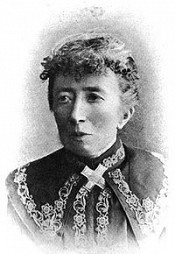Clerke Agnes Mary

Agnes Mary Clerke (10 February 1842 – 20 January 1907) was an astronomer and writer, mainly in the field of astronomy. She was born at Skibbereen, County Cork, Ireland, and died in London.[1] Agnes Clerke, the daughter of John Willis Clerke (c.1814 -1890) and his wife Margaret (b.c1819). The father was a judge's registrar.[2][3] She was interested in astronomy from an early age, and had begun to write about it before the age of 15. In 1861 her family moved to Dublin, and in 1863 to Queenstown. Several years later she went to Italy where she stayed until 1877, chiefly at Florence, studying at the public library and preparing for literary work. In 1877 she settled in London. Her first important article, Copernicus in Italy, was published in the Edinburgh Review in October 1877. She achieved a worldwide reputation in 1885, on the appearance of her exhaustive treatise, A Popular History of Astronomy during the Nineteenth Century. Clerke was not a practical astronomer, instead collating, interpreting and summarising the results of astronomical research. In 1888 she spent three months at the Cape Observatory as the guest of the director, Sir David Gill, and his wife, and there became sufficiently familiar with spectroscopic work to be enabled to write about this newer branch of the science with increased clearness and confidence. In 1892 she was awarded the Actonian Prize of 100 guineas by the Royal Institution. As a member of the British Astronomical Association she attended its meetings regularly, as well as those of the Royal Astronomical Society. In 1903, with Lady Huggins, she was elected an honorary member of the Royal Astronomical Society, a rank previously held only by two other women, Caroline Herschel and Mary Somerville. Her sister, Ellen Mary Clerke (1840–1906), also wrote about astronomy. The lunar crater Clerke is named after her. She also wrote 55 articles for the Edinburgh Review, mainly on subjects connected with astrophysics, and several articles for the Dictionary of National Biography, the Encyclopædia Britannica and the Catholic Encyclopedia, and several other periodicals.
do you like this author?
What readers are saying
What do you think? Write your own comment on this book!
write a commentWhat readers are saying
What do you think? Write your own comment on this author!
write a commentBook list

A Popular History of Astronomy During the Nineteenth Century
Series:
Unknown
Year:
Unknown
Raiting:
2.5/5
Originally published in 1886. This volume from the Cornell University Library's print collections was scanned on an APT BookScan and converted to JPG 2000 format by Kirtas Technologies. All titles scanned cover to cover and pages may include marks notations and other marginalia present in the original volume.
Show more
add to favoritesadd In favorites
Book list

A Popular History of Astronomy During the Nineteenth Century
Series:
Unknown
Year:
Unknown
Raiting:
2.5/5
Originally published in 1886. This volume from the Cornell University Library's print collections was scanned on an APT BookScan and converted to JPG 2000 format by Kirtas Technologies. All titles scanned cover to cover and pages may include marks notations and other marginalia present in the original volume.
Show more
add to favoritesadd In favorites
What readers are saying
What do you think? Write your own comment on this author!
write a commentif you like Clerke Agnes Mary try:
readers also enjoyed
What readers are saying
What do you think? Write your own comment on this author!
write a commentif you like Clerke Agnes Mary try:
readers also enjoyed
Do you want to exchange books? It’s EASY!
Get registered and find other users who want to give their favourite books to good hands!

